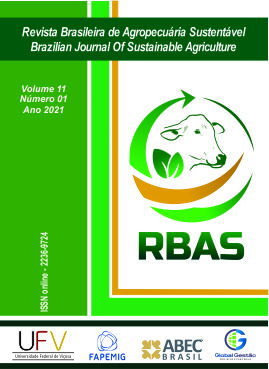ACOMPANHAMENTO DA FERMENTAÇÃO NA PRODUÇÃO DE HIDROMEL COM UTILIZAÇÃO DE Saccharomyces cerevisiae E Saccharomyces boulardii
FERMENTATION MONITORING IN MEAD PRODUCTION WITH THE USE OF Saccharomyces cerevisiae and Saccharomyces boulardii
DOI:
https://doi.org/10.21206/rbas.v11i1.11476Keywords:
produção de hidromel, Saccharomyces boulardii, fermentação alcoólicaAbstract
Mead is a fermented alcoholic beverage based on honey and water, considered one of the oldest drinks in the world being consumed by Vikings and Romans treated as a gift from the gods, the divine nectar. The yeast species most used in the manufacture of alcoholic beverages is Saccharomyces cerevisiae. But yeast of the species Saccharomyces boulardii, presents good fermentative action, besides bringing numerous health benefits. The objective of this work was to follow parameters indicative of fermentation using S. cerevisiae and S. boullardii in the production of mead. The experiment consisted of 2 treatments (A with S. cerevisiae and B with S. boulardii) with 3 replicates. Initially the honey was diluted in water, up to 20 ° Brix, and afterwards the addition of S. cerevisiae and S. boullardii was added and the fermentation process was carried out. Analyzes of total soluble solids (° Brix), pH, total titratable acidity (mEq/L) were carried out during fermentation and alcoholic content at the beginning and at the end of the fermentation process. Microbiological analysis was also performed to determine yeast counts at the beginning and at the end of the process. There was a reduction of pH and increase of acidity throughout the process for both treatments. Treatment S. boullardii presented a lower pH and higher acidity at the end of the fermentation process. For the total soluble solids content and alcohol content there was no significant difference between the treatments at the end of the fermentation. Both the S. cerevisiae formulation and the formulation with S. boulardii presented an excellent fermentative performance, promoting similar alterations in the physical-chemical parameters of the production.
Downloads
Downloads
Published
How to Cite
Issue
Section
License
Copyright (c) 2021 Brazilian Journal of Sustainable Agriculture

This work is licensed under a Creative Commons Attribution-NonCommercial-NoDerivatives 4.0 International License.
1. Proposta de Política para Periódicos de Acesso Livre
Autores que publicam nesta revista concordam com os seguintes termos:
Autores mantém os direitos autorais e concedem à revista o direito de primeira publicação, com o trabalho simultaneamente licenciado sob a Licença Creative Commons Attribution que permite o compartilhamento do trabalho com reconhecimento da autoria e publicação inicial nesta revista.











